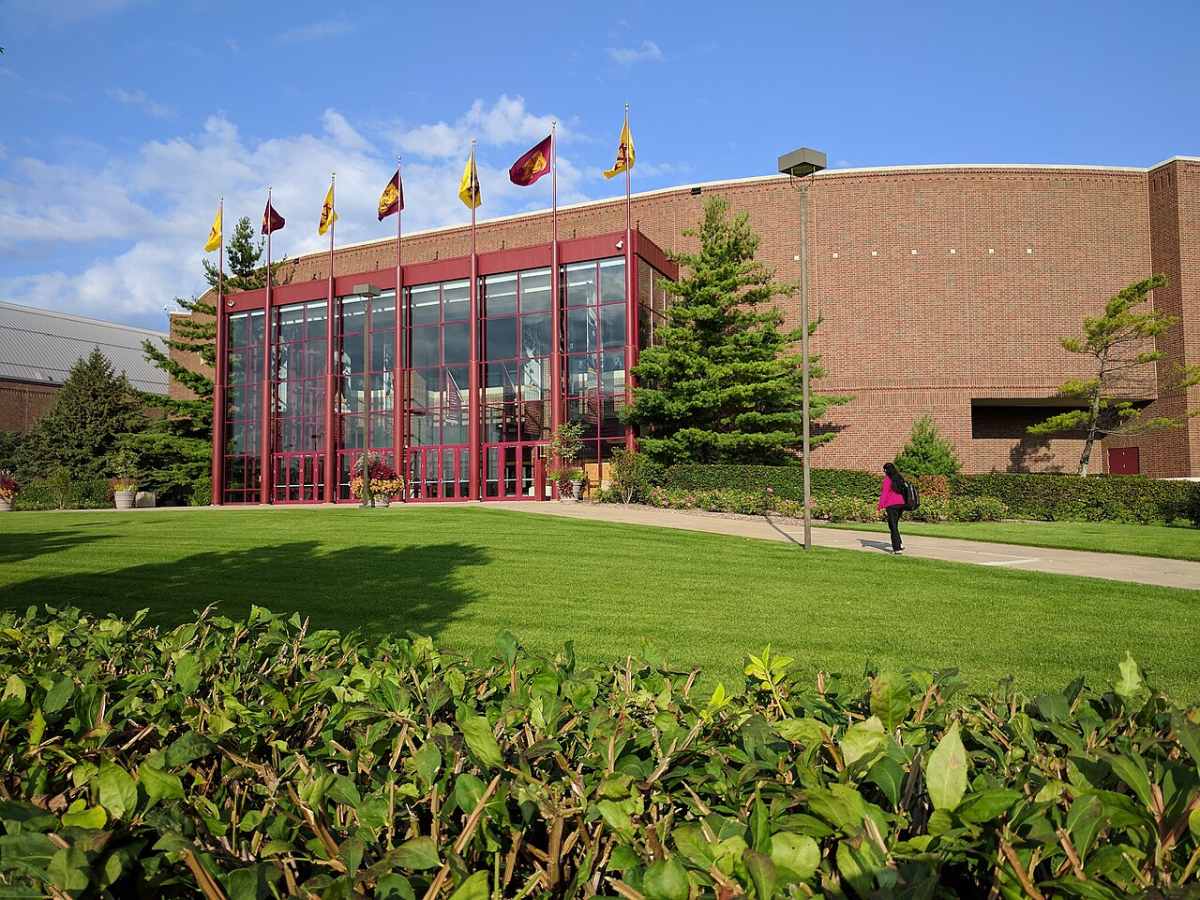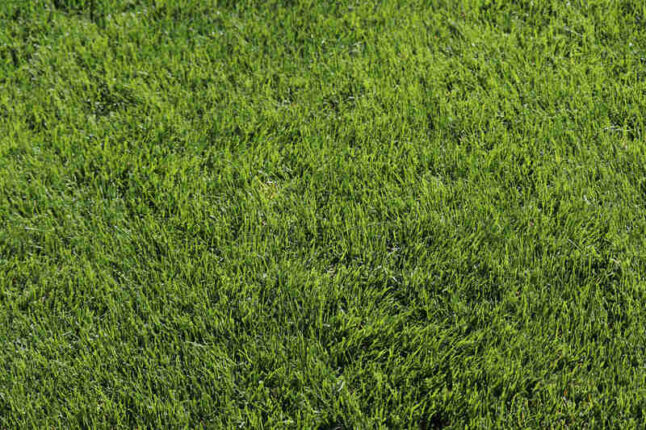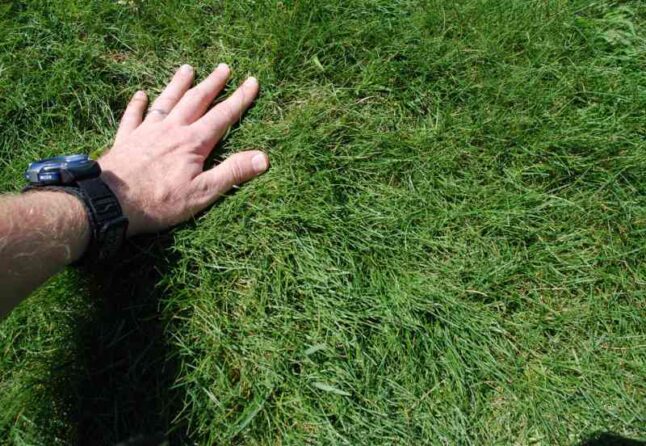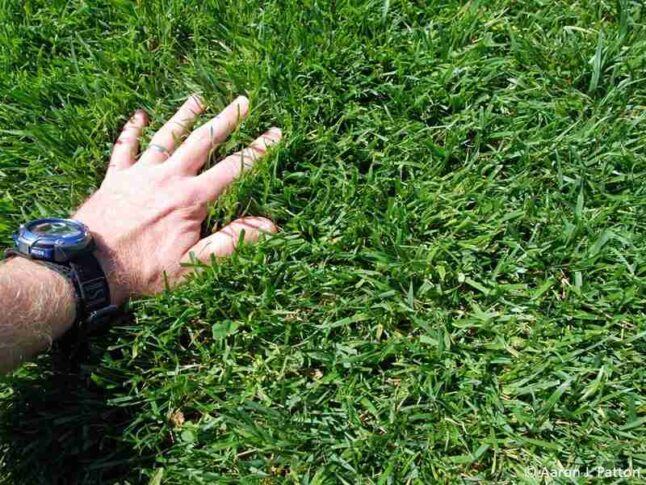
Kentucky bluegrass, perennial ryegrass, and several varieties of fescue are the best grass seeds for Minnesota lawns. They form a thick turf, survive our harsh winters, and match the beautiful scenery of the state.
But each of these grasses has different strengths and weaknesses, varying in their ability to tolerate shade, drought, foot traffic, and other stresses. It’s important to understand this to ensure the grass you choose matches your preferences and your lifestyle.
Grasses That Thrive in Minnesota
Minnesota’s USDA Hardiness Zone ranges from zone 3a in the north to zone 5a in most of Southern Minnesota. The state gets freezing winters that only cool-season grasses can handle.
Cool-season grasses grow best during early spring and fall when temperatures range from 55 to 75 degrees Fahrenheit. Here are the best cool-season grasses for Minnesota lawns:
Kentucky Bluegrass

Kentucky bluegrass is one of my favorites because it looks beautiful with its dark green leaves and gives your lawn a dense appearance. It grows vigorously in spring and fall and can withstand the harsh winters of Minnesota.
This grass has a medium-fine texture and is soft on bare feet. It’s also durable and can self-repair, thanks to rhizomes. Whether you have kids and pets playing in your yard or want to conduct backyard parties regularly, Kentucky bluegrass can handle them well. It grows best in full sun but can handle partial shade.
Kentucky bluegrass is a high-maintenance grass that requires frequent fertilization and watering.
When to Plant Kentucky Bluegrass
If you want to grow Kentucky bluegrass, early fall is the best time. This grass takes longer than other cool-season grasses to germinate at 14 to 28 days. However, it spreads quickly because of rhizomes.
Mow this grass as soon as it starts growing for healthy growth. Maintain a height of 2 to 3 inches. Check out our guide for more mowing tips.
Best Grass to Overseed
We recommend overseeding Kentucky bluegrass with tall fescue at a ratio of 90:10 to increase its resistance to diseases like dollar spot, leaf spot, and summer patch. The best time to overseed this grass is in the fall.
Check out our guide for more on growing Kentucky bluegrass.
- Classification: Cool-season grass
- Spreads by: Rhizomes
- Shade tolerance: Low
- Drought tolerance: Moderate
- Foot traffic tolerance: Moderate
- Maintenance needs: Moderate mowing frequency and high fertilization needs
- Mowing height: 2 to 3 inches
- Potential for disease: Moderate to high. Prone to several diseases, such as dollar spot, leaf spot, necrotic ring spot, summer patch, and stripe smut.
- Soil pH: 6 to 7.5
- Soil type: Performs best in well-drained, heavy soils with high fertility.
- Available as sod: Yes
| Pros | Cons |
| ✓ Looks beautiful ✓ Withstands foot traffic ✓ Excellent ability to self-repair ✓ Soft underfoot ✓ Spreads quickly | ✗ High water and fertilization requirements ✗ Low shade tolerance ✗ Prone to thatch, disease, and insects ✗ Long germination time |
Grass Seed Options:
– Jonathan Green (11970) Blue Panther Kentucky Bluegrass Grass Seed (3 lbs.)
– SeedRanch Midnight Kentucky Bluegrass Seed (5 lbs.)
– Jacklin Seed – Biltmore Blue Blend – 100% Kentucky Bluegrass (5 lbs.)
Perennial Ryegrass

Perennial ryegrass has dark green blades and grows vigorously in spring and fall. This grass looks patchy, but you can fix that by overseeding. Perennial ryegrass can handle the harsh winters of the North Star State exceptionally well.
This grass has a fine textured that makes it soft underfoot. Perennial ryegrass withstands high-foot traffic, but it doesn’t have rhizomes to self-repair, which is a shame because this grass is among the softest to walk on. If the grass thins or gets damaged, you should overseed. Perennial ryegrass prefers full sun.
Perennial ryegrass requires regular watering, but you don’t have to fertilize and mow the grass as often.
When to Plant Perennial Ryegrass
Early fall is the best time to plant perennial ryegrass. It germinates quickly in less than 10 days but takes longer to spread because it’s a bunch-forming grass.
Mow perennial ryegrass as soon as it starts growing and maintain a height of 1 to 3 inches.
Best Grass to Overseed
We recommend overseeding perennial ryegrass with Kentucky bluegrass at a ratio of 75:25 to give your lawn a denser appearance and help it self-repair. The best time to overseed this grass is fall.
Check out our guide for more on growing perennial ryegrass.
- Classification: Cool-season grass
- Spreads by: Has a bunch-type growth habit
- Shade tolerance: Low
- Drought tolerance: Low
- Foot traffic tolerance: High
- Maintenance needs: Moderate mowing and fertilization requirements. Thatch is not significant.
- Mowing height: 1 to 3 inches
- Potential for disease: High. Common diseases include gray leaf spot, red thread, and leaf spot/melting-out.
- Soil pH: Can grow in soils with a pH between 5 and 8 but prefers between 6 and 7.
- Soil type: Prefers good drainage and fertility but can tolerate poor drainage to some extent.
- Available as sod: Yes
| Pros | Cons |
| ✓ Germinates quickly ✓ Withstands foot traffic ✓ Not prone to thatch ✓ Soft underfoot ✓ Low mowing requirements | ✗ Looks patchy ✗ Doesn’t like shade ✗ Poor ability to recover from damages ✗ Prone to diseases and insects ✗ Spreads slowly |
Grass Seed Options:
– Outsidepride Perennial Ryegrass Seed (5 lbs.)
– Eretz ProTurf Perennial Ryegrass Fine Lawn Seed (choose your size)
Fine Fescue

Fine fescue is a group of five different fine-textured, medium-green grasses: Chewings fescue, sheep fescue, hard fescue, strong creeping red fescue, and slender creeping red fescue. These grasses grow best in spring and fall and can easily withstand the harsh winters of Minnesota.
Fine fescues are the softest of all cool-season grasses. However, they don’t withstand high-foot traffic. Creeping red fescue can repair itself from damage because it spreads by rhizomes. Other fine fescues don’t because they are bunch-forming. Fine fescues grow best in full sun but can survive with just four hours of dappled sunlight.
These grasses don’t require frequent fertilization and mowing, making them an excellent choice for homeowners who don’t want to spend much time maintaining their lawns. Fine fescues also resist drought.
When to Plant Fine Fescue
Early fall is the best time to plant fine fescues. They germinate and are established quickly but take longer to spread because they are bunch-type. Creeping fescue is an exception because it spreads by rhizomes.
Mow fine fescues as soon as they start growing and maintain a height of 1 to 3 inches.
Best Grass to Overseed
We recommend overseeding fine fescues with Kentucky bluegrass at a ratio of 50:50 or 75:25 to give your lawn a denser appearance and help it repair itself. Fall is the best time to overseed this grass.
Check out our guide for more on growing fine fescue.
- Classification: Cool-season grass
- Spreads by: Creeping red fescue spreads by rhizomes, while other fine fescues are bunch-type grasses, such as Chewings, hard, and sheep fescues.
- Shade tolerance: Moderate to high
- Drought tolerance: Moderate to high
- Foot traffic tolerance: Low
- Maintenance needs: Low fertilizer and mowing needs
- Mowing height: 1 to 3 inches
- Potential for disease: Moderate. Common diseases include red thread, leaf spot, dollar spot, summer patch, and powdery mildew.
- Soil pH: 6 to 6.5
- Soil type: Prefers drier soils and tolerates various soil types and fertility.
- Available as sod: Yes
| Pros | Cons |
| ✓ Looks beautiful ✓ Germinates quickly ✓ Resists drought ✓ Resists shade ✓ Soft underfoot ✓ Low fertilizer and maintenance needs | ✗ Doesn’t tolerate foot traffic well ✗ Doesn’t recover well when damaged ✗ Spreads slowly ✗ Prone to diseases and insects |
Grass Seed Options:
– Outsidepride Legacy Fine Fescue Grass Seed (5 lbs.)
– Eretz Creeping Red Fine Fescue Seed (choose your size)
– Outsidepride Creeping Red Fine Fescue Grass Seed (25 lbs.)
– Outsidepride Hard Fine Fescue Grass Seed (10 lbs.)
Tall Fescue

Tall fescue grows vigorously from spring to fall. It looks beautiful with coarse grass blades and medium to dark green leaves, but the lawn isn’t dense, especially compared to Kentucky bluegrass. Tall fescue can easily handle the harsh winters of Minnesota.
This grass isn’t the softest to walk bare feet but can withstand foot traffic relatively well. However, since it doesn’t have stolons or rhizomes to repair itself, you should overseed to fix damaged spots. Tall fescue prefers full sun but can survive with just four hours of dappled sunlight a day.
Tall fescue has an extensive root system, making it highly drought-resistant. However, it requires frequent mowing to be in good shape.
When to Plant Tall Fescue
The best time to plant tall fescue is early fall. It germinates and establishes relatively quickly but takes longer to spread because it’s bunch-forming. For healthier growth, wait until the grass blades grow at least four inches tall before mowing.
Best Grass to Overseed
We recommend overseeding tall fescue with Kentucky bluegrass at a ratio of 50:50 or 75:25. It gives your lawn a denser appearance and helps it repair itself. The best time to overseed this grass is fall.
Check out our guide for more about maintaining tall fescue.
- Classification: Cool-season grass
- Spreads by: Produces short rhizomes but has a bunch-type growth habit
- Shade tolerance: Moderate
- Drought tolerance: Moderate to high
- Foot traffic tolerance: Moderate
- Maintenance needs: Frequent mowing. Thatch is not significant.
- Mowing height: 2 to 4 inches
- Potential for disease: Tolerates most diseases when maintained properly
- Soil pH: 5.5 to 6.5
- Soil type: Adapted to a wide range of soil conditions but prefers fertile clay soils with good drainage.
- Available as sod: Yes
| Pros | Cons |
| ✓ Germinates quickly ✓ Withstands foot traffic ✓ Not prone to thatch ✓ Resists drought ✓ Resists shade ✓ Resists diseases | ✗ Looks patchy ✗ Poor ability to recover from damages ✗ Spreads slowly ✗ Requires frequent mowing |
Grass Seed Options:
– Triple-Play Tall Fescue Grass Seed Blend (5000 sq ft)
– Eretz Kentucky 31 K31 Tall Fescue Grass Seed (choose your size)
– Pennington The Rebels Tall Fescue Grass Seed Mix (7 lb.)
Best Grasses for Minnesota by Region
Minnesota is a large state, and there will be some variations in the climate depending on the region. Here are the best grass seeds for Minnesota by region.
Best Grasses for Northwest Minnesota
Northwest Minnesota gets mild summers and bitterly cold winters. This region is among the snowiest in the United States. Kentucky bluegrass, fine fescue, and tall fescue grow best here.
Best Grasses for Northeast Minnesota
Northern Minnesota is called the Icebox of America for a reason. Like Northwest Minnesota, Northeast Minnesota gets mild summers and bitterly cold winters. Kentucky bluegrass, fine fescue, and tall fescue are the best grasses for the entire region, from Crosslake to Ely to Isle.
Best Grasses for Central Minnesota
From Saint Augusta to Sauk Rapids to Sartell, Central Minnesota gets mild summers and cold winters. Kentucky bluegrass, perennial ryegrass, fine fescue, and tall fescue grow well here.
Best Grasses for Southwest Minnesota
Kentucky bluegrass, perennial ryegrass, fine fescue, and tall fescue perform best in Clinton, Correll, and the entire Southwest Minnesota. They handle warm summers and cold winters exceptionally well.
Best Grasses for Southeast Minnesota
Southeast Minnesota gets warm summers and cold winters. Cool-season grasses like Kentucky bluegrass, perennial ryegrass, fine fescue, and tall fescue do well in our warm summers and cold winters.
How to Choose the Best Grass for Your Minnesota Lawn
When choosing the type of grass to plant, you should consider your yard’s characteristics, lifestyle, and the local climate.
Soil Type
Minnesota has different types of soil. Here are the best grasses for each soil:
- Loamy: Perennial ryegrass, fine fescue, tall fescue
- Silty: Kentucky bluegrass, tall fescue
- Sandy: Fine fescue
- Peat: Tall fescue
Maintenance Level
High-maintenance grasses look great. But most homeowners don’t have much time or money to spend on their lawns.
- High-maintenance grasses: Kentucky bluegrass
- Moderate-maintenance grasses: Tall fescue, perennial ryegrass
- Low-maintenance grasses: Fine fescue
Foot Traffic
If you frequently host backyard parties or play sports with your children, choose grasses that withstand high-foot traffic.
- High foot traffic: Perennial ryegrass
- Moderate foot traffic: Kentucky bluegrass, tall fescue
- Low foot traffic: Fine fescue
Drought Tolerance
Minnesota gets enough rain and isn’t too hot, so you don’t have to worry much about growing thirsty grass. However, if your lawn has water constraints, choose grasses that withstand drought better.
- Moderate drought tolerance: Kentucky bluegrass, tall fescue, fine fescue
- Low drought tolerance: Perennial ryegrass
Shade Tolerance
If your lawn doesn’t get enough sunlight because of the shade from trees or buildings, choose a grass that can thrive with minimal sunlight.
- Moderate shade tolerance: Tall fescue, fine fescue
- Low shade tolerance: Kentucky bluegrass, perennial ryegrass, Bermudagrass
FAQs
Tall fescue and fine fescue are an excellent choice for shaded lawns.
Minnesota is home to over 1,800 plant species. These plants can transform your lawn from ordinary to extraordinary:
Rough blazing star (Liatris aspera)
Blue false indigo (Baptisia australis)
Swamp milkweed (Asclepias incarnata)
Foamflower (Tiarella)
Lavender Hyssop (Agastache foeniculum)
Seeding refers to sowing seeds in the soil, while sodding is installing pre-grown grass for instant coverage. If you want a lush lawn overnight, sodding is the right choice. But it’s expensive.
When to Hire a Professional
Cool-season grasses are the best choice for Minnesota’s continental climate. If you need help choosing and planting the right grass or with any lawn maintenance activities, get in touch with LawnStarter pros. Our pros have the skills and experience to transform your backyard from boring to beautiful.
LawnStarter participates in the Amazon Services LLC Associates Program, an affiliate advertising program. LawnStarter earns revenue from products promoted in this article.
Main Photo Credit: Runner1928 / Wikimedia Commons / CC BY-SA 4.0